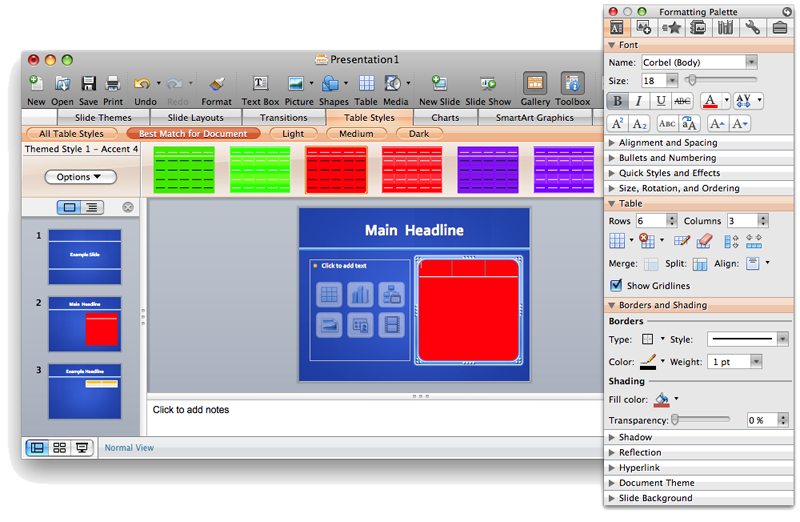

Loop until Stopped: Once the audio clip finishes, it starts again indefinitely until you stop it. If you’re using Office 2010, you’ll also find an option here to play the audio clip during the entire presentation. Start: Click the drop-down arrow to choose how you want the audio to start. Volume: It allows you to set the volume of the clip. In the Audio Options group, you’ll find the following options to adjust the behavior of the audio clip:. If you click it, a new window will open, where you can set the start point and the end point of the audio clip. In the Editing group, there are options to add a fade in and a fade out. These can be helpful if you want to quickly find the main points in your audio during the presentation. In the Bookmarks group, you’ll find an option to add bookmarks, which will be visible in the timeline. A new set of tabs, called Audio Tools, will appear on the toolbar. Select the audio whose format you want to adjust. You can refer to the “ Editing Audio” section in this tutorial if you want more information. You’ll also need to uncheck “Play Across Slides”. Please note that if you want to play a different audio in each slide, you’ll need to add the audio files one by one. 
If you want to export any audio included in your PowerPoint presentation, right-click its icon → Save Media As (you can only do this with audio inserted from your PC).
 Select the option that best suits your needs. However, there could be issues if you use the presentation in a different computer, forcing you to link the audio file to the presentation again. If you choose Link to File, a link to the file will be created, reducing the size of the document. If you choose Insert, the audio will be directly inserted into your presentation, increasing the size of the document. Once located, click the drop-down arrow next to Insert. A new window will open, where you have to locate the audio file you want to add to your presentation. You’ll see two options: the first one allows you to add audio from your PC, whereas the second one allows you to record audio (you’ll need to have a microphone set up in your computer). On the Insert tab, in the Media group, click the Audio drop-down arrow. Open your PowerPoint presentation and select the slide where you want to add audio. If you’re using a newer version, we recommend that you work with AAC. Before we begin, please note the following: in PowerPoint 2010 or older, you should use. Watch the demonstration above to see these steps in action. When you’re finished, click Keep Changes. On the Background Removal Tool tab, click Mark Areas to Remove and select any other area that you want to remove. Adjust the selection to cover the area of the image that you want to keep. PowerPoint will automatically select the part of the image to be kept. On the Format tab, click Remove Background. Click on the image that has background you want to remove. To remove the background from a picture in PowerPoint: In a few simple steps, you can create praiseworthy presentations and nobody will ever know you did all that fancy image-editing right within PowerPoint.
Select the option that best suits your needs. However, there could be issues if you use the presentation in a different computer, forcing you to link the audio file to the presentation again. If you choose Link to File, a link to the file will be created, reducing the size of the document. If you choose Insert, the audio will be directly inserted into your presentation, increasing the size of the document. Once located, click the drop-down arrow next to Insert. A new window will open, where you have to locate the audio file you want to add to your presentation. You’ll see two options: the first one allows you to add audio from your PC, whereas the second one allows you to record audio (you’ll need to have a microphone set up in your computer). On the Insert tab, in the Media group, click the Audio drop-down arrow. Open your PowerPoint presentation and select the slide where you want to add audio. If you’re using a newer version, we recommend that you work with AAC. Before we begin, please note the following: in PowerPoint 2010 or older, you should use. Watch the demonstration above to see these steps in action. When you’re finished, click Keep Changes. On the Background Removal Tool tab, click Mark Areas to Remove and select any other area that you want to remove. Adjust the selection to cover the area of the image that you want to keep. PowerPoint will automatically select the part of the image to be kept. On the Format tab, click Remove Background. Click on the image that has background you want to remove. To remove the background from a picture in PowerPoint: In a few simple steps, you can create praiseworthy presentations and nobody will ever know you did all that fancy image-editing right within PowerPoint. 
The Remove Background feature in PowerPoint 2016 helps you eliminate distracting backgrounds so the important parts of your image are front-and-center. PowerPoint has many built-in tools that make editing photos and images a breeze.
CHANGE BACKGROUND IMAGE IN POWERPOINT 2008 FOR MAC SOFTWARE
But you don’t need to be a professional designer or have pricey, complicated software to give your work the style it deserves. Technology offers a lot of tools to help you design and present visually attractive work.








 0 kommentar(er)
0 kommentar(er)
